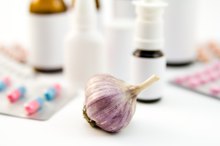How to Get Rid of IUD Odor
An IUD--intra-uterine device--is a small pregnancy prevention device that is inserted into the uterus via the cervix. With any pregnancy prevention device, there is a possibility of side effects. According to NetDoctor: "Infections are a little more common in IUD users, and are most likely to cause symptoms in the three weeks following insertion." An infection can cause a change in the color and smell of vaginal discharge. However, odor after an IUD insertion does not necessarily mean an infection. If the odor is accompanied by pain, bleeding or a fever, consult your primary care physician or OB/GYN as soon as possible.
Add plain yogurt to your diet. Yogurt contains lactobacillus, which is a good bacteria that can aid in restoring your vaginal pH balance.
How to Freshen Yourself After Menstrual Cycle
Learn More
Soak a tampon in plain, unsweetened yogurt for several hours. Insert the tampon into your vagina to help eliminate odors. Keep the tampon inside your vagina for a few hours. After the allotted time, remove the tampon and clean the area with water.
Combine a few drops of tea tree oil with lukewarm water. Cleanse your vagina with the tea tree oil-water mixture. Tea tree oil is a natural antiseptic with antifungal qualities.
Symptoms of an Endometrial Ablation Infection
Learn More
Change your diet. A diet that contains alcohol and spiced foods can promote vaginal odor. Eat more vegetables and fresh fruits such as blueberries, bananas, spinach and oranges. These foods are high in antioxidants and can eliminate vaginal odor. Drink more water to help remove vaginal odor.
Wear loose clothing and cotton panties 1. Tight clothing and synthetic panties can increase vaginal sweating. Loose clothing and cotton panties provide better air circulation to your vagina.
Related Articles
References
- Net Doctor: Contraceptive coils (IUDs)
- STD Facts - Bacterial Vaginosis. Centers for Disease Control and Prevention. Feb 8, 2017.
- STD Facts - Trichomoniasis. Centers for Disease Control and Prevention. Jan 31, 2017.
- Rodrigues CF, Rodrigues ME, Henriques M. Candida sp. Infections in Patients with Diabetes Mellitus. J Clin Med. 2019;8(1) doi:10.3390/jcm8010076
- Pelvic inflammatory disease. womenshealth.gov. Apr 1, 2019.
Writer Bio
Amanda Flanigan began writing professionally in 2007. Flanigan has written for various publications, including WV Living and American Craft Council, and has published several eBooks on craft and garden-related subjects. Flanigan completed two writing courses at Pierpont Community and Technical College.








